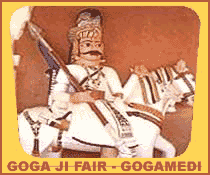| GOGAJI
FAIR, GOGA MEDI |
|
| Celebrated at
:
59 Kms. away from Jaipur, Rajasthan. |
|
| Attraction :
Goga Medi |
|
|
|
| Gogaji Fair is held in the memory
of a popular hero of the area who is known as Goga Veer among the Hindus and
Jahar Peer among the Muslims. The Kayam Khani Muslims claim descent from him
and regard him as a peer (saint). The devotees of Gogaji can be found in Uttar
Pradesh, Punjab, Madhya Pradesh and Maharashtra. In Gujarat, an annual
procession is taken out in honour of the great warrior. |
|
| Gogaji is popular as a snake-god and almost
every village in Rajasthan has a 'Than' (sacred place) dedicated to him.
Staunch believers have faith that invoking Gogaji will help to cure a snake
bite or other diseases and many visit the Gogaji Fair to make a wish or for
expressing their gratitude when their wishes come true. |
 |
|
|
| It is believed that Gogaji went
into 'samadhi' at the place now known as Goga Medi and thousands of devotees
gather to pay homage at this memorial annually in the month of Bhadrapada
during the Gogaji Fair, which lasts for 3 days. |
|
| The 'samadhi' is a marble
structure with two minarets and fortified by a boundary wall. The idol of
Gogaji is seated on a blue horse with a snake coiled around the neck. An
inscription in Persian can be seen at the main entrance, which describes Mahmud
Ghazni's regard for Gogaji. He had arranged for the renovation of the memorial
as a token of gratitude when his wish was fulfilled |
|
| OFFERINGS &
RITUALS |
| The main mode of worship is
rubbing incense at the samadhi. Offerings of coconuts, 'batashas' (sugar drops)
and cash are made at the samadhi. Priests are engaged by the devout for
conducting special prayers in which praises of Gogaji are sung. The atmosphere
inside the hall is serene and sanctified. Fragrance and incense heighten the
feeling of purity and devotion.
|
|
| Outside the main hall, Nath
priests can be seen carrying whips (replicas of Gogaji's 'chabuk'), which are
considered lucky and offerings are made to them. Many people can be seen
singing and dancing, carrying multicoloured flags called 'nishans' in their
hands. Drums and gongs provide rhythm to the hymn singing. |
|
|
|
|
|